Table of Contents
ToggleSTINGS AND BITES.
Stings and bites refer to injuries caused by animals, insects, or plants that break the skin surface and can result in various reactions, ranging from minor irritation to severe medical conditions.
The terms “sting” and “bite” are used to differentiate between the type of injury and the mechanism by which it occurs.
- Insect bites occur when insects like mosquitoes, fleas, or bedbugs use their mouthparts to break the skin and feed on blood. These bites usually cause itching.
- Insect stings occur when insects, such as bees, wasps, or hornets, use a barbed stinger or another body part to pierce the skin and inject venom as a defense mechanism.
Other Animal Bites and Stings:
- Animal bites, such as dog bites, occur when an animal uses its teeth to break the skin.
- Animal stings, like those from jellyfish or scorpions, occur when an animal uses a specialized body part to inject venom into the skin.
- Plant Stings: Some plants have tiny needles or hairs on their leaves that can break off and lodge into the skin, causing discomfort. These are known as stinging plants
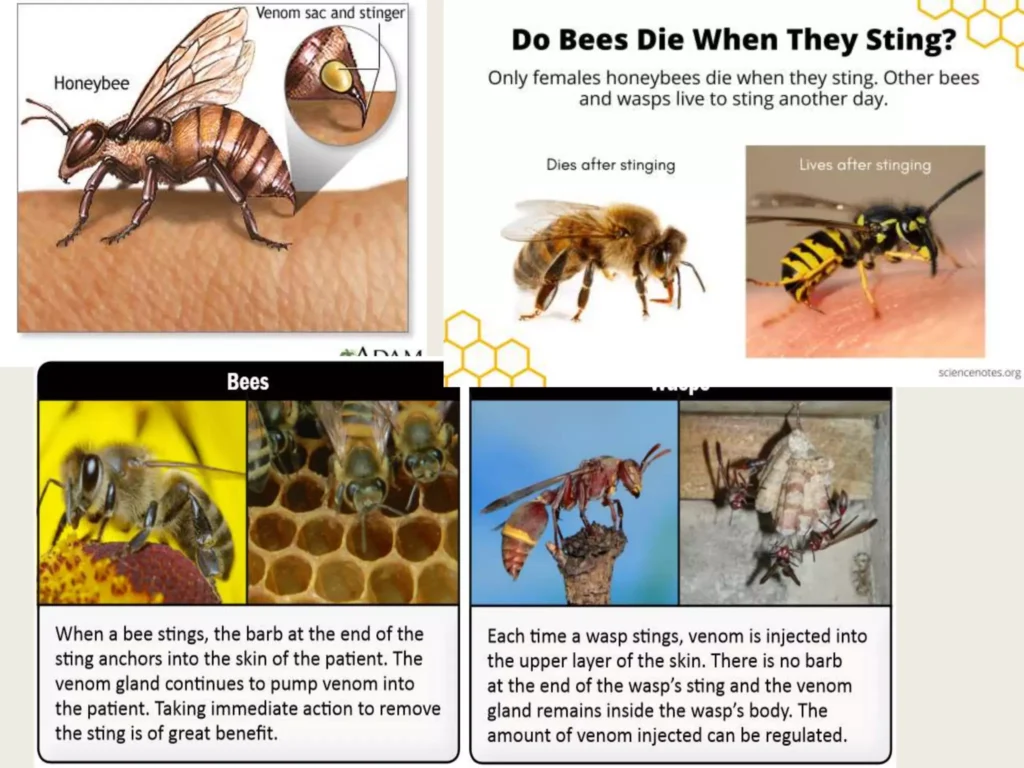
INSECTS STINGS AND BITES
Causes of Insect Stings and Bites:
- Insects: Insects such as bees, wasps, hornets, mosquitoes, and ants are common causes of stings and bites.
- Arachnids: Arachnids like spiders and ticks can also cause stings and bites.
- Environmental Factors: Spending time outdoors in areas where insects are prevalent, such as forests, gardens, or fields, increases the risk of being stung or bitten.
- Provocation: Insects may sting or bite if they feel threatened or provoked. For example, bees and wasps may sting if they perceive a threat to their nest or hive.
- Attractants: Certain scents, perfumes, bright colors, and sweet foods can attract insects and increase the likelihood of being stung or bitten.
- Seasonal Factors: Insect activity tends to be higher during warmer months, increasing the chances of encountering stinging or biting insects.
- Geographic Location: The prevalence of specific insects varies by region, so the risk of stings and bites may be higher in certain areas.
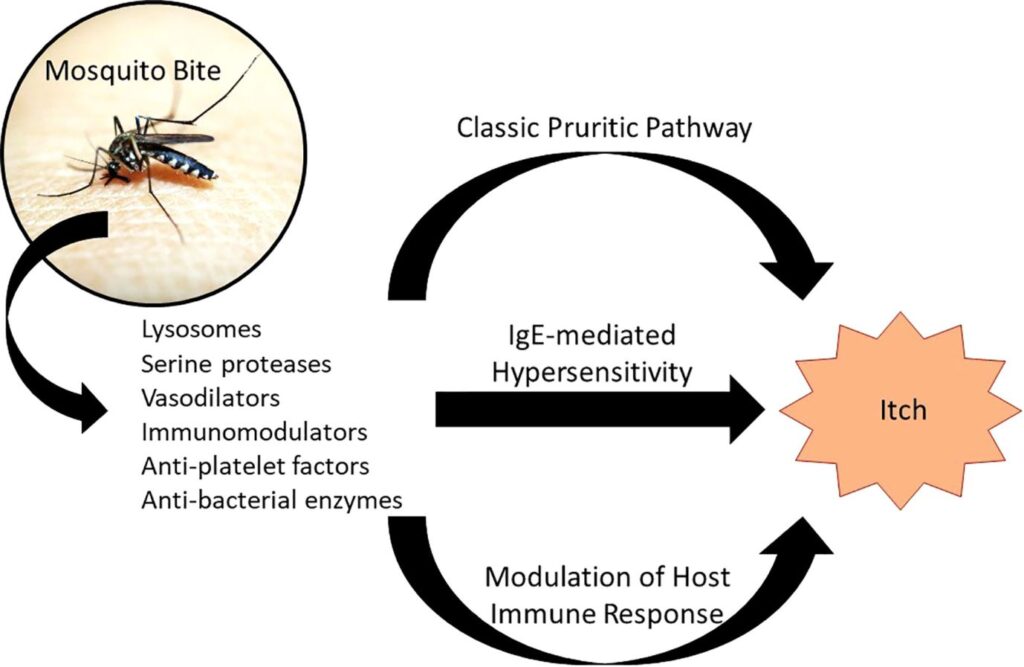
Pathophysiology of Insect Stings and Bites:
- Exposure: When an insect stings or bites, it injects venom or saliva into the skin through its mouthparts or stinger.
- Venom/Saliva: The venom or saliva contains various substances that can trigger an immune response and cause local and systemic effects.
- Immune Response: The immune system recognizes the foreign substances in the venom or saliva and releases chemicals, such as histamine, to defend against them.
- Local Effects: The release of histamine and other chemicals leads to local inflammation, causing redness, swelling, pain, and itching at the site of the sting or bite.
- Systemic Effects: In some cases, the venom or saliva can cause systemic effects, affecting other parts of the body. This can occur due to an allergic reaction or a toxic reaction to the venom.
Signs and Symptoms of Insect Stings and Bites:
When it comes to insect stings and bites, there are several signs and symptoms that can occur. These can range from mild irritation to more severe allergic reactions.
Localized Reactions:
- Localized redness and swelling at the site of the sting or bite.
- Itching and irritation.
- Pain or tenderness.
- Formation of a small blister or weal.
- Development of a rash or hives.
- In some cases, a visible puncture mark or stinger may be present.
Systemic Reactions:
- Dizziness.
- Weakness.
- Nausea.
- Headache.
Signs and Symptoms of Anaphylaxis:
Anaphylaxis is a severe allergic reaction that can occur in response to an insect sting or bite. It is a medical emergency and requires immediate attention. The signs and symptoms of anaphylaxis may include:
- Difficulty breathing or wheezing.
- Swelling of the face, lips, tongue, or throat.
- Rapid heartbeat or palpitations.
- Severe itching or hives over a large area of the body.
- Nausea, vomiting, or abdominal pain.
- Feeling of impending doom or anxiety.
- Loss of consciousness or collapse.
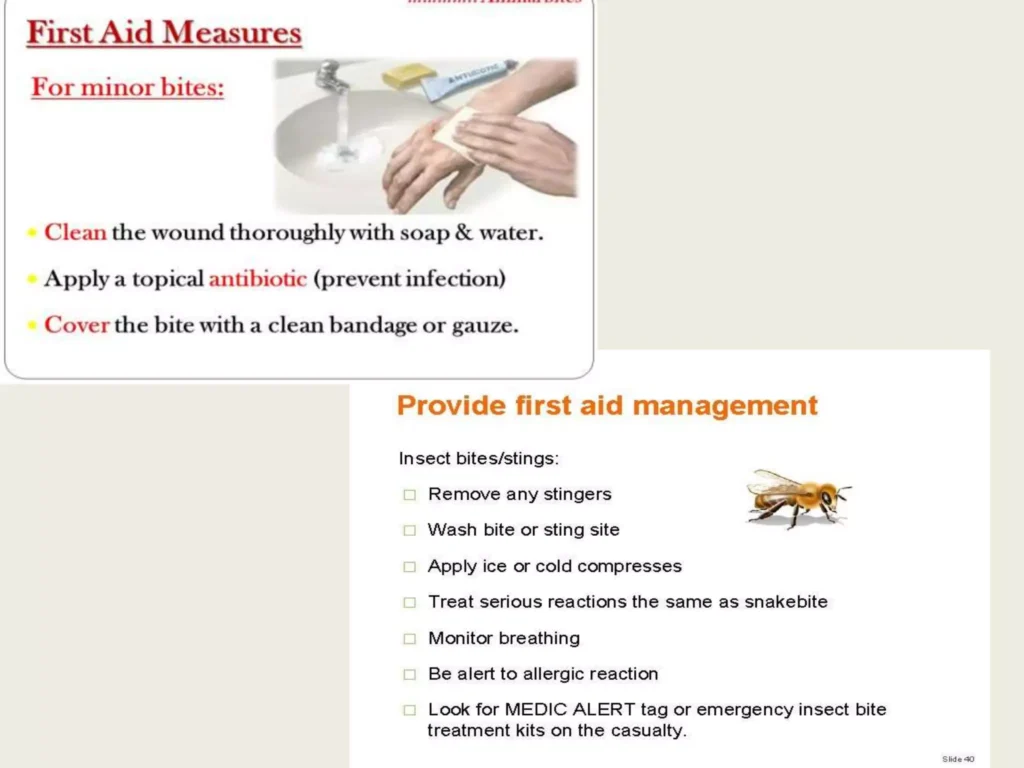
Management of Insect bites and stings.
- Reassure the casualty and keep them calm.
- Apply constant firm pressure to the sting area using the edge of a blunt object or your fingernail. Scrape or brush off the sting. Avoid using tweezers as they may squeeze the venom sac and increase venom release.
- If the sting is on the fingers or hands, remove any rings or watches in case of swelling.
- Remove the sting by scraping with a straight-edged object across the stinger. Do not use tweezers – these may squeeze the venom sac and increase the amount of venom released.
- Wash the site thoroughly with soap and water. Then, follow these steps:
- Place ice (wrapped in a washcloth) on the site of the sting for 10 minutes and then off for 10 minutes. Repeat this process. Avoid direct contact with the skin to prevent frostbite.
- If necessary, take an antihistamine or apply creams that reduce itching.
- Over the next several days, watch for signs of infection (such as increasing redness, swelling, or pain).
- Advise the casualty to see a doctor if the pain and swelling persist.
- DO NOT apply a tourniquet or give the person stimulants, aspirin, or other pain medicine unless prescribed.
Diagnosis.
- History of a bite or stung by an insect
- Physical exam-view of the swollen site.
- Skin allergic test
Medical management.
In mild cases, insect stings and bites may be managed without drug therapy. However, in more severe cases, the following drug therapies may be used:
- Anti-histamines: These can help relieve itching and reduce allergic reactions.
- Steroids: Systemic steroids may be prescribed to reduce inflammation and allergic responses.
- Epinephrine: In cases of anaphylaxis, epinephrine (adrenaline) may be administered to reverse severe allergic reactions.
- Prophylactic antibiotics: In certain cases, antibiotics may be prescribed to prevent infection.
Safety precautions to consider:
- Use insect repellents to help prevent insect stings.
- Wear long pants and a T-shirt to minimize exposed skin.
- If you encounter an attack, cover your face and run in a straight line as quickly as possible.
- Grab a net, coat, towel, or any object that can provide temporary protection.
- Seek shelter in a house, tent, or car with windows and doors closed.
- Avoid other people as they may also come under attack.
- Be aware that bees can pursue for up to 400 meters.
- Bees are slow fliers, and most people can outrun them.
- Stay alert for bees entering or exiting through cracks in walls.
- Once you notice a bee colony, do not provoke it and keep a safe distance.
When to Seek Emergency Care:
- Trouble breathing, wheezing, or experiencing shortness of breath.
- Swelling anywhere on the face or in the mouth.
- Throat tightness or difficulty swallowing.
- Feeling weak or experiencing a sudden drop in blood pressure.
- Turning blue or experiencing a loss of consciousness.
Prevention of Insect stings and bites.
- Avoid rapid, jerky movements around insect hives or nests.
- Avoid wearing perfumes and clothing with floral patterns or dark colors, as they can attract insects.
- Use appropriate insect repellents and wear protective clothing, such as long sleeves and pants.
- Exercise caution when eating outdoors, especially around garbage cans or sweetened beverages that may attract bees.
- If you have severe allergies to insect bites or stings, it is important to have an emergency kit and an EpiPen. Ensure that your friends and family know how to use it in case of a reaction.
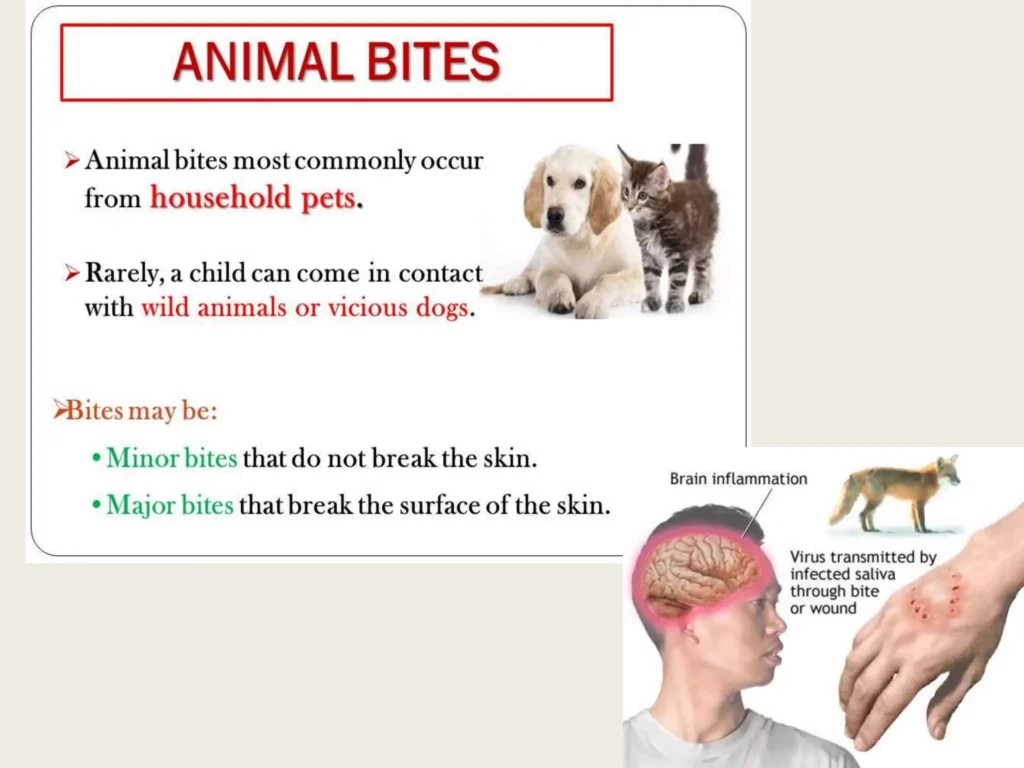
ANIMAL BITES
Animal bites, especially in children, are a common occurrence and can result in puncture wounds. It is important to properly manage these bites to prevent complications such as infection and the transmission of diseases like rabies.
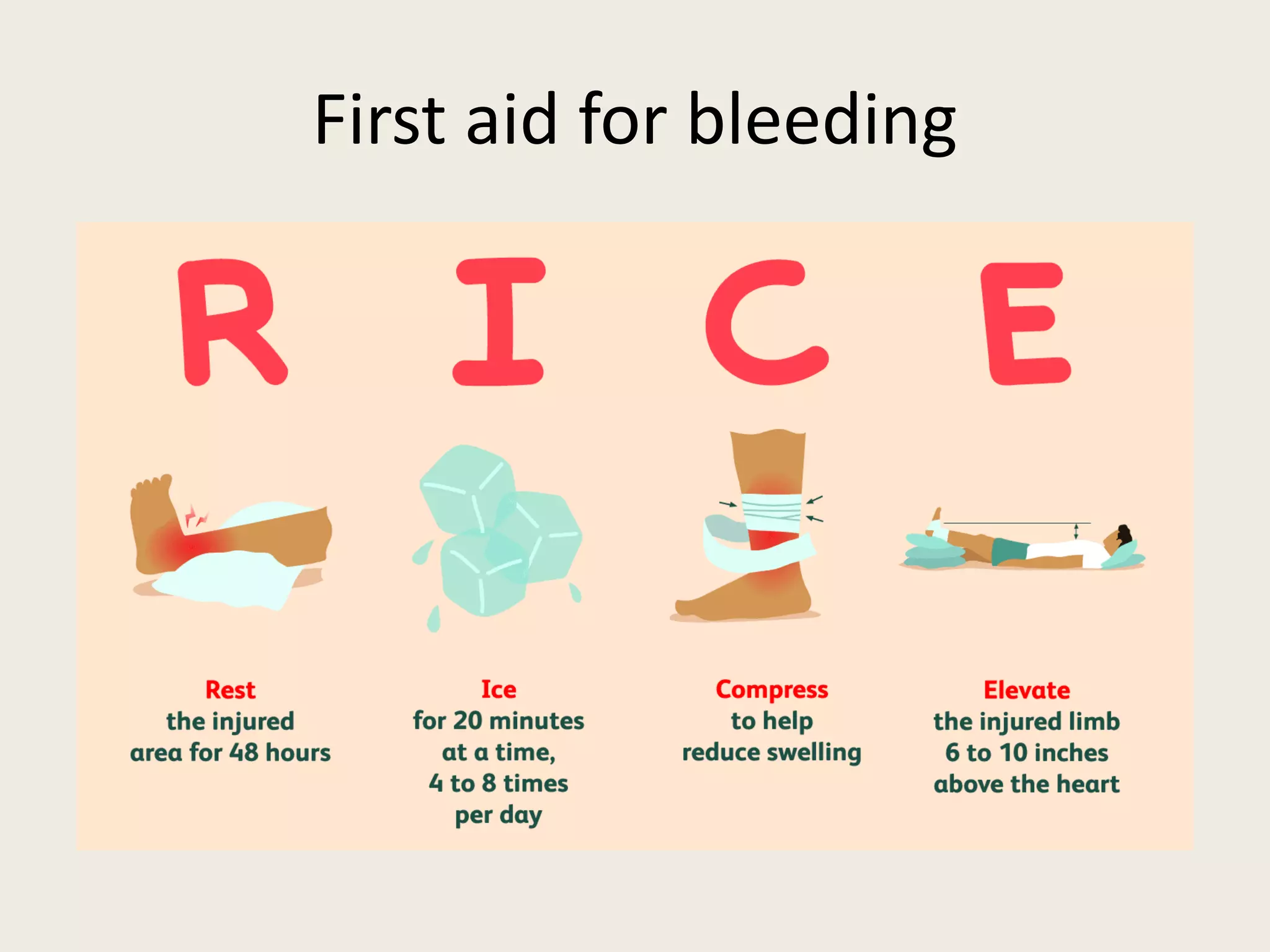
General Wound Care:
- Rinse the wound with saline water or sterile water under pressure to remove any dirt or debris.
- Wash the surrounding skin with soap and water to reduce the risk of infection.
- Apply a clean dressing to protect the wound and promote healing.
- If possible, elevate the affected body part to help control bleeding.
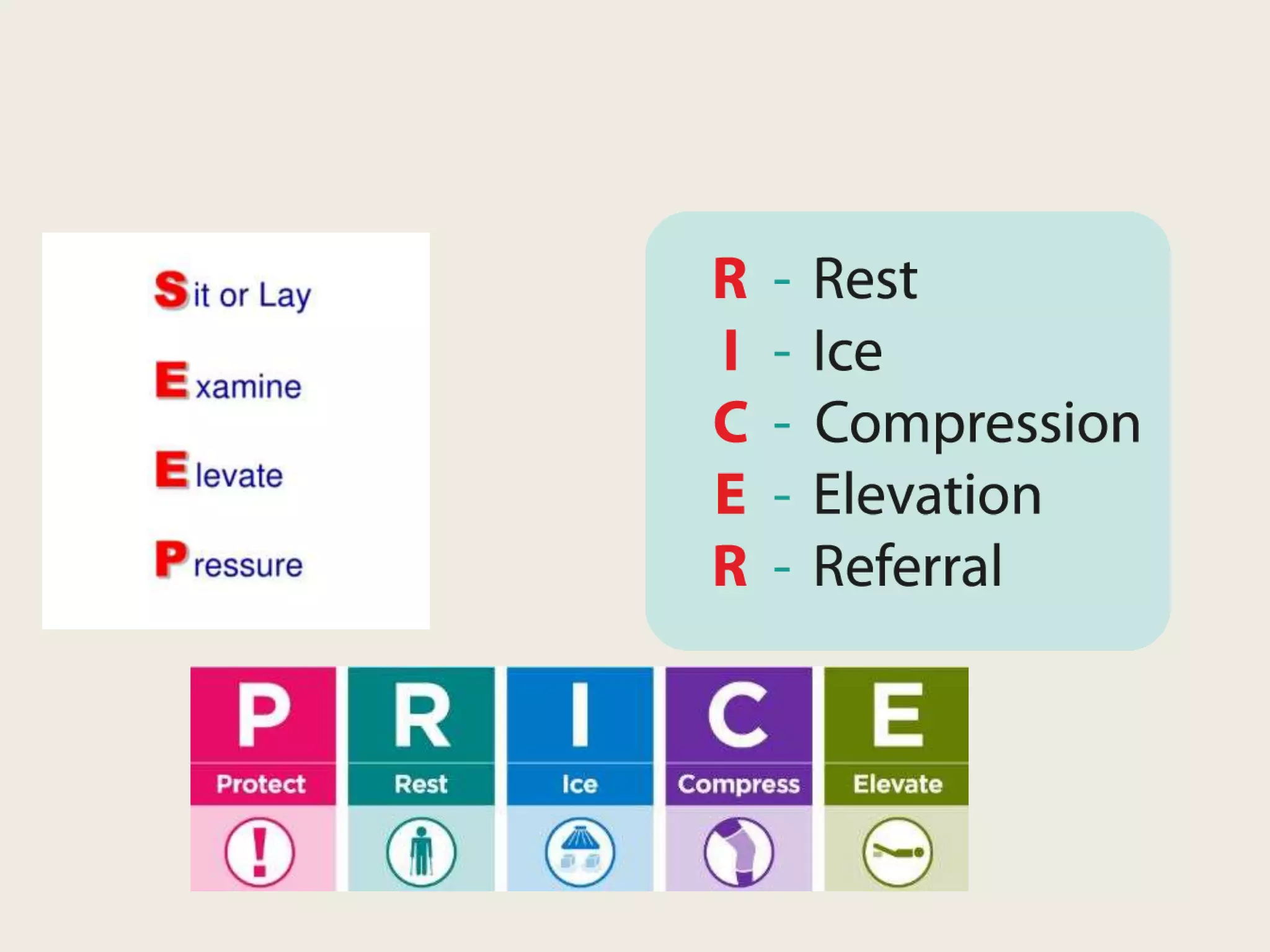
Medical Interventions:
- Tetanus toxoid should be administered if the person has not been adequately vaccinated against tetanus.
- Prophylactic antibiotics may be prescribed to prevent infection, especially in high-risk wounds or individuals with immune deficiencies.
- Debridement of lacerations may be necessary to remove damaged tissue and promote healing.
Suspected Rabies Infection:
- If there is a suspicion of rabies infection, immediate medical attention is crucial.
- Anti-rabies immunoglobulins, such as inactivated rabies vaccines, may be administered to induce an active immune response.
- Rabies Ig (preformed antibodies) may also be given to provide immediate protection against the virus.
Animal Safety:
- Teach children how to prevent interactions with unfamiliar animals.
- Vaccinate your pets regularly to protect them against diseases and reduce the risk of bites.
- Avoid teasing or provoking animals, as this can lead to aggressive behavior.
- Do not make direct eye contact with a threatened animal, as it may perceive it as a challenge.
- Never pull an animal’s tail or take away its food, as this can agitate them.
- Approach restrained animals with caution and respect their space.
- Avoid running in front of a dog, as it may trigger their instinct to chase.
- Do not allow inexperienced individuals to feed dogs, as they may not understand proper handling techniques.
- Alert animals to your presence before approaching them to avoid surprising or startling them.
- Consider spraying your pets with appropriate insect repellents to prevent bites from insects like fleas and ticks.
- Socialize your animals to ensure they are comfortable and well-behaved around people.
- Do not allow children to lead dogs, as they may not have the necessary control or understanding of the animal’s behavior.

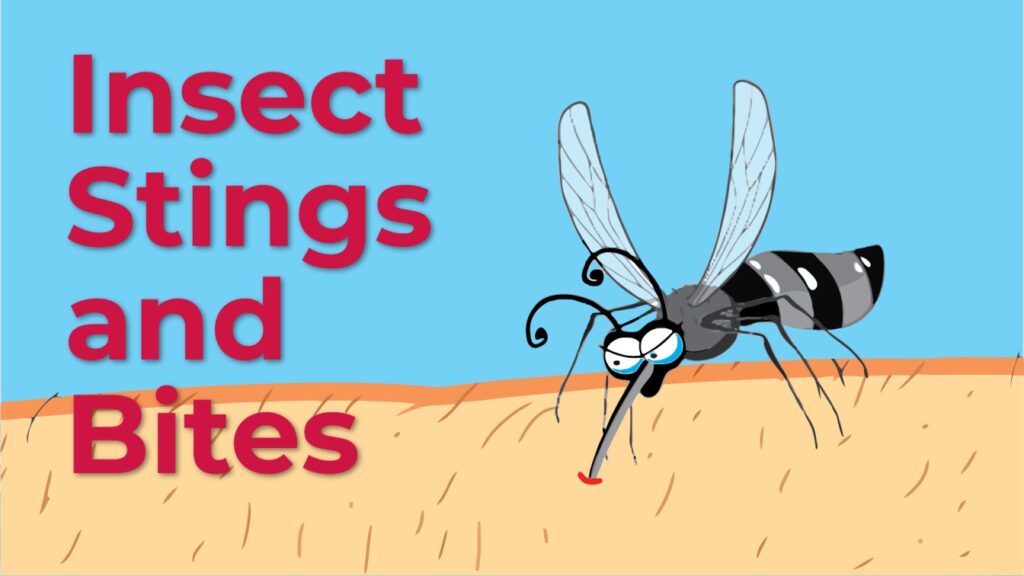
What of snake bite first aid management